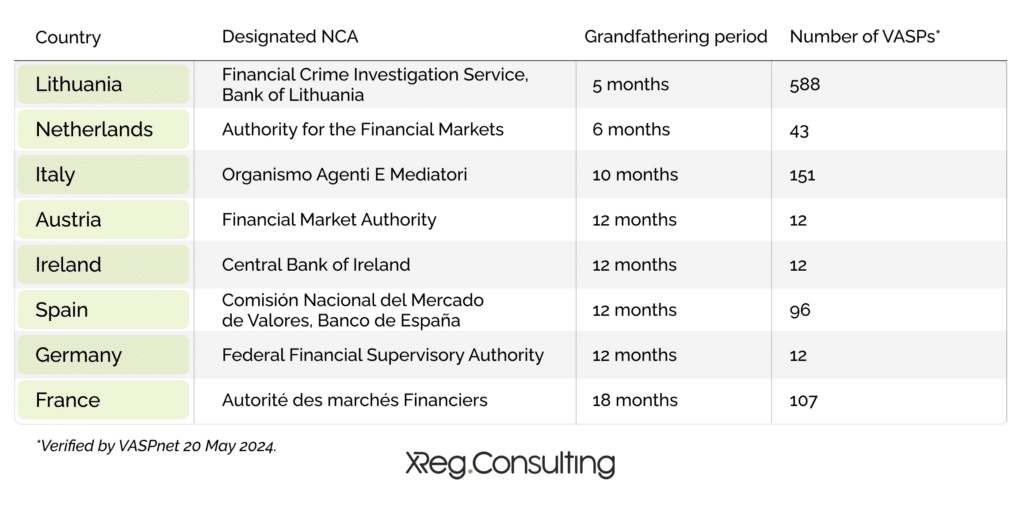crypto regulation
Presidential debate may clarify crypto regulatory approach
Published
6 days agoon
By
admin

Moe Vela, a former senior advisor to President Joe Biden, shared his thoughts on crypto’s possible role in tonight’s presidential debate.
The presidential debate between incumbent Joe Biden and former President Donald Trump may very well be the most televised event this year. For cryptocurrency enthusiasts, the debate comes at a time when digital assets like Bitcoin (BTC) and Ethereum (ETH) have become hot topics in Washington.
In addition to approved spot BTC ETFs, expected spot ETH ETF greenlights, and crypto bills like FIT 21, Grayscale Investments and The Harris Poll reports stated that “nearly half of likely American voters think some of their future investment portfolios will include crypto.”
Will crypto come up in the debate?
Moe Vela, a senior advisor at Unicoin, told crypto.news in an interview that moderators may not field crypto-related questions. But he expects at least one candidate to comment on crypto in some form.
As previously reported, Trump said Bitcoin mining might be an antidote to proposed central bank digital currencies (CBDCs). Trump announced that all Bitcoin mining should happen in America and has styled himself the “crypto president.”
Although Trump has seemingly rebranded his candidacy as pro-crypto, the former U.S. President shared skeptical remarks in the past. In 2021, Trump called Bitcoin a scam that affected the U.S. dollar’s value.
Vela suggested that Trump‘s crypto u-turn might be “political bluster.” However, the former White House advisor stressed that “both candidates and their campaigns MUST soon be clear about what type of regulatory environment they will develop and enforce.”
Under Biden’s administration, government agencies like the Securities and Exchange Commission (SEC) and the Federal Deposit Insurance Corporation (FDIC) have tightened the noose around crypto in an attempt to protect investors from risky investments.
Per Vela’s comments, “regulators and governmental agencies too often can be overzealous in their oversight roles,” and “regulators who are in denial and using regulations to obstruct, discourage, dismantle or destroy a sector are dangerous. “
As the litigation strategy for digital asset oversight received backlash from industry proponents, Biden’s administration has also issued an Executive Order (EO) mandating a whole-of-government approach to crypto policies.
Carole House, one of the authors behind President Joe Biden’s EO, recently returned to the White House ahead of the elections. Vela believes the development signals the current regime’s recognition of crypto’s integral role in America’s future.
Whatever the case, as cryptocurrencies become more embedded in U.S. society, Vela emphasized that leaders should balance being pro-sector and pro-consumer to benefit innovation and investor freedom.
Source link
You may like


Taliban jailed 8 traders for holding and using crypto


Solana Struggles to Rise Amid Bitcoin Price Uncertainty


Developing in Web 3.0 Is on the Cusp of a Breakthrough


Digital Shovel Sues RK Mission Critical for Patent Infringement on Bitcoin Mining Containers


crypto will get positive regulation ‘no matter who wins’ election


Toncoin (TON) v Cardano (ADA): On-chain Data Show Gains
Circle
Circle Awarded Europe’s First Stablecoin License Under New MiCA Crypto Rules
Published
1 day agoon
July 2, 2024By
admin
Cryptocurrency firm Circle has achieved a significant milestone by securing registration as an electronic money institution (EMI) in France. This move grants Circle a crucial license to operate as a compliant stablecoin issuer under the European Union’s rigorous crypto laws.
Circle Breakthrough
According to a CNBC report, the approved license positions Circle as the first global stablecoin issuer to achieve compliance with the European Union’s regulatory framework known as Markets in Crypto-Assets (MiCA).
This framework, considered a cornerstone in the EU’s approach to governing cryptocurrencies, sets out comprehensive rules and obligations for crypto companies to ensure investor protection and safeguard against market manipulation.
Related Reading
Circle’s acceptance into the MiCA regulatory framework means that both its USDC and Euro Coin (EURC) tokens can now be issued within the European Union while meeting the stablecoin regulatory obligations outlined by MiCA.
Additionally, Circle is opening up its Circle Mint service, enabling businesses to mint and redeem Circle stablecoins, to customers in France.
Expressing his satisfaction with the achievement, Jeremy Allaire, co-founder and CEO of Circle, emphasized the company’s longstanding commitment to building compliant and well-regulated infrastructure for stablecoins. He stated:
Our adherence to MiCA, which represents one of the most comprehensive crypto regulatory regimes in the world, is a huge milestone in bringing digital currency into mainstream scale and acceptance.
European Stablecoin Adoption
The EU’s MiCA law, which officially came into effect in May 2023, introduced the world’s first comprehensive regulatory framework for cryptocurrency operations.
Last week, provisions specifically governing stablecoins were approved, imposing stringent measures on trading volume limitations for certain stablecoins, particularly those denominated in US dollars.
As a registered EMI in France, Circle can now extend its services, including the minting and redemption of USDC through Circle Mint, not only to customers in France but also to individuals and businesses across the European Union.
This is made possible by the concept of “passporting” outlined in MiCA, which allows crypto businesses to offer services in one EU country and expand into other markets within the bloc.
Related Reading
While Circle’s achievement is commendable, it should be noted that additional obligations under MiCA about crypto asset service providers will become applicable by December 30, 2024. Crypto companies will then have until July 2026 to ensure full compliance with MiCA’s requirements.
Since its launch in September 2018 by Circle and crypto exchange Coinbase, USDC has gained significant traction and now holds the position of the second-largest stablecoin globally.
According to CoinGecko data, USDC’s circulation amounts to $32.4 billion, trailing only Tether’s USDT, which holds the title of the world’s largest stablecoin with a circulation of $112.7 billion.
Featured image from Shutterstock, chart from TradingView.com
Source link
Bitcoin
Bitcoin ATM installations reach 38k, below the all-time high
Published
2 days agoon
July 1, 2024By
admin

The global Bitcoin ATM market has seen significant growth. There are now over 38,000 Bitcoin ATMs worldwide, up from just over 10,000 in October 2020 and down by 2,000 from its all-time high (ATH) of nearly 40,000 in December 2022.
According to data available on Coin ATM Radar, the global tally of installed Bitcoin ATMs stands at 38,279 as of the latest count.
This expansion is driven by factors such as accessibility and ease of use, profitability for operators who earn transaction fees above the Bitcoin spot price, and favorable regulatory environments in many countries that support setup and expansion.
Additionally, Bitcoin ATMs provide enhanced privacy and security, allowing users to transact without divulging personal information and enabling direct deposits into digital wallets.
Despite their advantages, the industry faces challenges. Many operators lack the necessary experience, financial backing, or business acumen required for success, compounded by regulatory uncertainties in certain regions.
To address these issues, industry leaders emphasize the importance of public education on the benefits of cryptocurrencies and the need for reliable customer support. Building greater understanding and trust among users could encourage broader adoption of Bitcoin ATMs and digital assets.
As demand grows for convenient and secure cryptocurrency transactions, the Bitcoin ATM market is poised for further expansion. Strategic approaches and supportive regulatory frameworks could propel this industry into a pivotal role in the global adoption of digital assets.
Bitcoin holds steady at $60k
Bitcoin’s (BTC) price trajectory in 2024 has been marked by significant volatility and a bullish momentum. March saw Bitcoin achieving a new all-time high, surpassing $69,000 and briefly touching $73,000 before undergoing a correction.
This surge was driven by pivotal events this year: regulators approved the first spot Bitcoin ETFs in January, and April’s halving event reduced the block reward from 6.25 BTC to 3.125 BTC.
Experts anticipate a new growth cycle in the crypto market, potentially peaking between 2024 and 2025, in line with the four-year market cycle theory.
However, external factors such as global developments and regulatory changes could also influence Bitcoin’s price trajectory. Despite ongoing scrutiny of Bitcoin’s long-term prospects, its historical resilience suggests the possibility of a rebound.
Analysts maintain optimism regarding Bitcoin’s future price movements, with some forecasting it could surpass $80,000 in the coming years.
Over the past 60 days, the Bitcoin price has risen by 7.3%, climbing from approximately $57,000 to its current level of $61,532.
Source link
blockchain-based business
Cryptocurrency after the European Union’s MiCA regulation
Published
2 days agoon
June 30, 2024By
admin
Disclosure: The views and opinions expressed here belong solely to the author and do not represent the views and opinions of crypto.news’ editorial.
The Markets in Crypto-Assets Regulation (MiCA) marks a significant milestone in the European Union’s journey toward regulating the rapidly evolving crypto market. Its timeline and provisions hold immense importance for both crypto businesses and investors. As we approach crucial dates, starting with the application of stablecoin provisions from June 30, 2024, and the complete application of MiCA on December 30, 2024, the crypto landscape is undergoing a transformative phase.
Over the next two years
MiCA’s staggered timelines and transitional periods, extending up to June 30, 2026, imply a period of fragmented implementation across the EU and European Economic Area (EEA). Jurisdictions such as Ireland (12 VASPs), Spain (96 VASPs), and Germany (12 VASPs) will grant a 12-month transitional period. In contrast, other jurisdictions will offer more extended periods, such as France (107 VASPs) with 18 months, while Lithuania (588 VASPs) will likely only grant five months. This transitional phase will prompt market consolidation as not all existing service providers will secure MiCA licenses. Many will look to capitalize on this interim period before winding down operations.
The race among EU/EEA jurisdictions to become the primary hub for crypto activities intensifies, with jurisdictions like France, Malta, and Ireland competing to take the top spot. However, regulator readiness and compliance for crypto-asset businesses pose significant challenges. Regulators are facing an adjustment period to upskill their staff to process MiCA applications, particularly in jurisdictions with high applicant volumes. The complexity of various business models, encompassing numerous products unfamiliar to regulators, exacerbates this challenge. The general lack of expertise to authorize and supervise this sector requires substantial training efforts.

Challenges for crypto businesses
MiCA, coupled with the vast array of related Level-2 measures (many of which still need to be finalized) and other applicable EU instruments such as the anti-money laundering laws, the Digital Operational Resilience Act (DORA), and the Electronic Money Directive (EMD), create a complex regulatory framework. Understanding what provisions apply to each entity type and what documentation needs to be implemented will be challenging for some.
The delisting of crypto-assets, particularly stablecoins, from EU exchanges due to their issuers’ failure to obtain their licenses on time will pose considerable hurdles and limit the availability of certain assets for consumers.
Adapting to MiCA will strain many entities and require substantial investments in technological infrastructure. The Travel Rule, a requirement in which information must be shared between VASPs with each crypto transaction, also comes into effect at the same time as MiCA. The Travel Rule mandates that CASPs transfer a substantial amount of information about the originator. This includes their address, personal identification number, and customer identification number. In rare cases, it may even require the disclosure of the originator’s date and place of birth. This adds another layer of complexity, further highlighting the need for harmonization within the EU and solutions to comply with the Travel Rule that are interoperable and enable secure data sharing while preserving user privacy.
Key crypto market outcomes
Despite the challenges, MiCA instils confidence in EU entities due to heightened regulatory oversight, the promotion of investor protection and attracting mainstream institutional participation. Enhanced consumer protection measures mitigate risks such as fraud and hacking, fostering trust among retail clients.
MiCA’s reporting requirements will result in regulators across the EU possessing more data, empowering them to monitor market activities effectively. The ability to freely passport activities across the EU will facilitate cross-border operations and reduce regulatory fragmentation while expanding market reach.
MiCA’s prescriptive nature and all-encompassing regime set a precedent for global regulatory frameworks. Other jurisdictions are already observing and may replicate some of MiCA’s provisions and its approach, contributing to regulatory harmonization on a worldwide scale. However, concerns remain as to whether it will stifle growth and innovation and whether businesses will look to relocate to more permissive and less restrictive jurisdictions.
Steps after MiCA
MiCA’s gaps in regulating emerging areas like true defi (the provision of financial services or issuance of financial assets without identifiable intermediaries and with no single point of failure), lending, and NFTs necessitate ongoing policy discussions and further regulatory measures. Reports on these aspects will inform future regulatory developments, potentially leading to a second iteration of MiCA in at least the next four to five years or supplementary measures.
MiCA signals a new era of regulation in the crypto market, aiming to balance innovation with investor protection and market integrity. While challenges persist, MiCA lays the groundwork for a more transparent, secure, and inclusive crypto framework in the EU and beyond. As the crypto landscape continues to evolve, regulatory regimes must adapt to emerging trends and technologies, ensuring sustainable growth and fostering investor confidence.

Ernest Lima
Ernest Lima is one of the founding Partners at XReg Consulting and a qualified lawyer with over 17 years of experience working in financial services regulation. As XReg’s legal and regulatory policy lead, he is highly experienced in the design, development, and implementation of crypto legislative frameworks that meet both global and local policy objectives. At XReg, Ernest leverages in-house expertise on Europe’s Markets in Crypto-Assets (MiCA) Regulation to advise European clients or those looking to enter the European market. He also leads engagement with European public sector officials and National Competent Authorities in their transition to MiCA compliance. Ernest has also spoken at industry conferences and trained international regulatory authorities on Europe’s MiCA regulation and how it will shape the future of crypto’s international regulatory landscape. He also sits on the Financial Markets Law Committee to address issues arising from using cryptoassets and DLT.
Source link

Taliban jailed 8 traders for holding and using crypto

Solana Struggles to Rise Amid Bitcoin Price Uncertainty

Developing in Web 3.0 Is on the Cusp of a Breakthrough

Digital Shovel Sues RK Mission Critical for Patent Infringement on Bitcoin Mining Containers

crypto will get positive regulation ‘no matter who wins’ election

Toncoin (TON) v Cardano (ADA): On-chain Data Show Gains

Crypto Markets Like Their Odds With Kamala Harris

How Financial Surveillance Threatens Our Democracies: Part 2

CleanSpark’s amped hashrate mined 445 Bitcoin in June

Ripple and Coinbase Use Binance Win to Contest SEC Claims

DCG, Top Executives Renew Push to Get New York AG’s Civil Fraud Suit Dropped

Introducing Satoshi Summer Camp: A Bitcoin Adventure for Families

US judge approves expedited schedule for Consensys suit against SEC

2 Cryptocurrencies To Buy Boosting Into Top 10

Bitcoin Miners Slow Down Selling In July, What This Could Mean For Price

Bitcoin Dropped Below 2017 All-Time-High but Could Sellers be Getting Exhausted? – Blockchain News, Opinion, TV and Jobs

What does the Coinbase Premium Gap Tell us about Investor Activity? – Blockchain News, Opinion, TV and Jobs
BNM DAO Token Airdrop

NFT Sector Keeps Developing – Number of Unique Ethereum NFT Traders Surged 276% in 2022 – Blockchain News, Opinion, TV and Jobs
A String of 200 ‘Sleeping Bitcoins’ From 2010 Worth $4.27 Million Moved on Friday
New Minting Services

Block News Media Live Stream

SEC’s Chairman Gensler Takes Aggressive Stance on Tokens – Blockchain News, Opinion, TV and Jobs

Friends or Enemies? – Blockchain News, Opinion, TV and Jobs

Enjoy frictionless crypto purchases with Apple Pay and Google Pay | by Jim | @blockchain | Jun, 2022

How Web3 can prevent Hollywood strikes

Block News Media Live Stream

Block News Media Live Stream

XRP Explodes With 1,300% Surge In Trading Volume As crypto Exchanges Jump On Board

Block News Media Live Stream
Trending

 Altcoins2 years ago
Altcoins2 years agoBitcoin Dropped Below 2017 All-Time-High but Could Sellers be Getting Exhausted? – Blockchain News, Opinion, TV and Jobs

 Binance2 years ago
Binance2 years agoWhat does the Coinbase Premium Gap Tell us about Investor Activity? – Blockchain News, Opinion, TV and Jobs
- Uncategorized3 years ago
BNM DAO Token Airdrop

 BTC1 year ago
BTC1 year agoNFT Sector Keeps Developing – Number of Unique Ethereum NFT Traders Surged 276% in 2022 – Blockchain News, Opinion, TV and Jobs

 Bitcoin miners2 years ago
Bitcoin miners2 years agoA String of 200 ‘Sleeping Bitcoins’ From 2010 Worth $4.27 Million Moved on Friday
- Uncategorized3 years ago
New Minting Services

 Video2 years ago
Video2 years agoBlock News Media Live Stream

 Bitcoin1 year ago
Bitcoin1 year agoSEC’s Chairman Gensler Takes Aggressive Stance on Tokens – Blockchain News, Opinion, TV and Jobs

